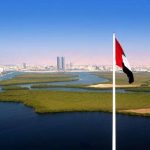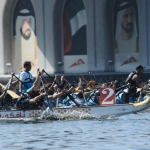Greek botanist in bid to save native plants of Ras Al Khaimah
Marina Tsaliki steps over a stream, that formed from the morning rain, in Wadi Showka and scans the landscape. Her eyes register a cluster of tall palms, evidence of permanent pools, and a few tumbleweeds.
“That’s usually a sign of overgrazing,” says Ms Tsaliki. “Because look, they’re all over. Grazing is always an issue, the camels and the goats.”
It is all in a day’s work for Ms Tsaliki, a soft-spoken Greek botanist for the Landscape Agency at Ras Al Khaimah Municipality’s Department of Public Works.
She is in a race against time to document the flora of Ras Al Khaimah in all its variety, from the mountain iris to fleshy, pungent desert red thumbs that attract flies with their odour.
Her survey will provide a baseline as habitats are lost to industrialisation and pushed to the brink by a changing climate.
The project began last October with a one-week survey of Jebel Jais. The agency was so impressed with her work that she was asked to expand the survey across the emirate.
Ms Tsaliki can be found roaming wadis, marshes and dunes at least three or four days a week, from sunrise to sunset.
“I sometimes just sit on a rock and look around. It is amazing what effort has been put into nature,” says Ms Tsaliki, who has done similar surveys in Oman and Greece. “Glossonema varians has roots that are these funny looking thingies that turn bright pink when the fruits mature. Like, why do they do that? And these are edible, the fruits are eaten.”
The plants she records flourish in one of the world’s most extreme climates. The emirate averages less than 14 centimetres of rain a year and summer temperatures can hit 50C.
Because of such extremes, plants not only change season to season but year to year. On rainy years, flowers dormant for years unfurl and cover wadi basins. Now in her second winter season. Ms Tsaliki has developed a keen eye for the remarkable.
The Emirates have comparatively few plant species for an area its size. The known species number is about 680, with around 350 in Ras Al Khaimah. But what grows is all the more remarkable for its ability to flourish in what, to the untrained eye, appears to be a barren and lifeless landscape.

Wadi Showka is particularly diverse. Ms Tsaliki surveys can find 15 to 20 different species of flora in a 100 square meter patch.
As she surveys, she speaks enthusiastically about species like Desmidorchis arabica, a “wacky, not very pretty” succulent and the joys of finding unexpected greenery cascading from cliffs. “The fern I found last week last week, I fell in love with it because it was just so tiny and it was like, ah, ‘I found you.’”
Her data will identify key areas for conservation in the face of rapid residential and industrial expansion.
Development into the desert and mountains has accelerated since 2011 when the federal government increased housing grants to tens of thousands of Emiratis and invested billions in roadworks and infrastructure projects.
“Development is always good but sometimes development moves into areas that are just unique and if you have a specific habitat type in one place and once this place is used, it’s gone and so are all the plants which are there.”
Read more: The National





